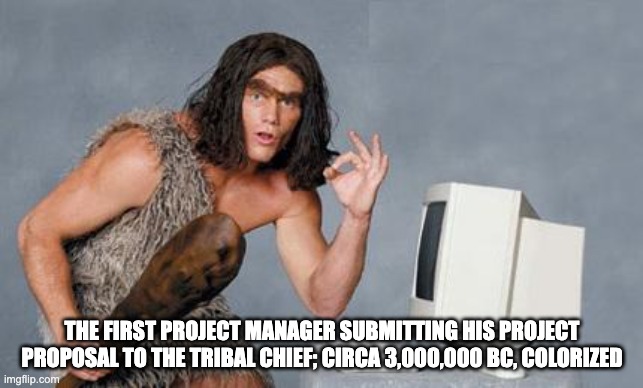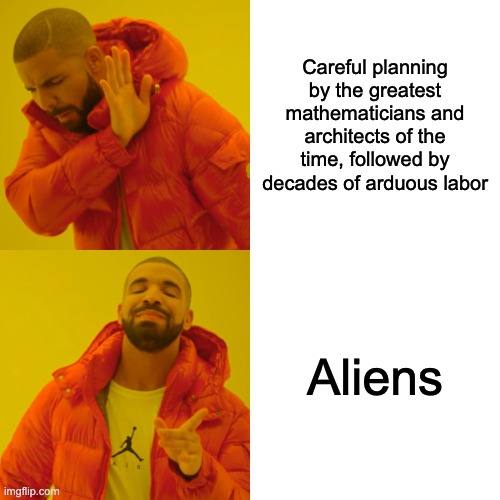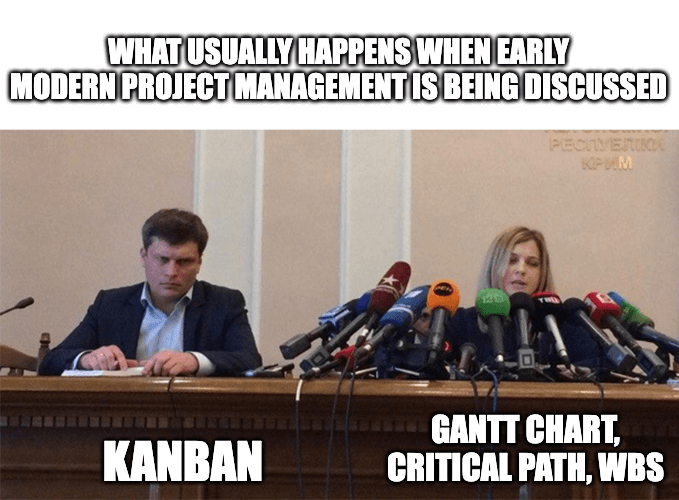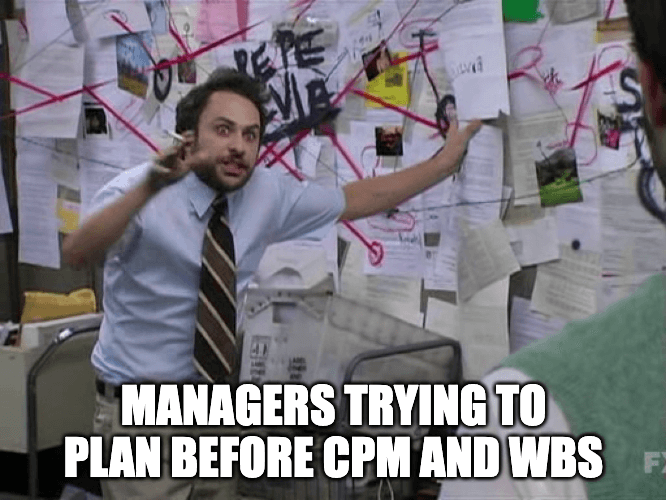Project management as we know it today can be traced back to the early 20th century. But, people have been coming together to create massive projects long before that: from the factories of the first industrial revolution all the way back to megalithic structures of prehistory.
That said, while project management has a long history, going over every painstaking detail isn’t the goal here today.
Instead, here’s a short overview of the history of project management, with a side of memes, because who said history has to be boring?

In this article:
Prior to the 20th century — from prehistory to the Industrial Revolution
A project is defined in PMBOK as “a temporary endeavor undertaken to create a unique product, service or result.” So, technically, the first project in the history of humanity was likely the first time someone sharpened a rock to make the first human-made tool.

However, whenever we talk about this subject, we tend to think of grander, collaborative projects. Our minds often go to achievements such as the Pyramids of Giza, Stonehenge, Göbekli Tepe, or the Great Wall of China.
Now, the reason some of these projects are so fascinating to us is that we simply don’t know how they were built, which has also spawned countless, (in)famous conspiracy theories.
Whatever the truth may be, those early projects didn’t involve any of the methodologies or terminology we have today. However, they absolutely involved logistics, planning, and management.

The key to understanding the reality of these grand undertakings — from the Pyramids to great medieval cathedrals — is time.
People can accomplish virtually anything given enough time. When time and efficiency weren’t exactly pressing factors, these monuments took years, decades, and even centuries to complete. Notre Dame, for example, took a whopping 200 years to build.
The need for a faster, more organized, and more structured approach to projects arose following the Industrial Revolution and the population explosion that accompanied it.
The early 20th century — the Gantt chart and the beginnings of modern project management
In the 1890s, a Polish engineer by the name of Karol Adamiecki invented the harmonogram, marking the beginning of modern project management planning.
The harmonogram was expanded upon and popularized in the English-speaking countries by Henry Gantt in the 1910s, which is why it’s commonly known today as the Gantt chart.
The Gantt chart addressed several of the major pain points of early project management by:
- Providing an intuitive visual overview of the project schedule, and
- Providing insight into task dependencies.
In essence, it allowed managers to do more in less time.

However, the term “project management” still didn’t exist, and “project manager” wasn’t a formally defined role — and it wouldn’t be for another half-century. Instead, leaders had to rely on their own skills, shared experience, and some proven best practices to see their projects through.
It’s fascinating to think about the massive projects such as the Hoover Dam being executed this way, but it also speaks volumes of what dedicated minds can and did accomplish throughout history when given enough resources, time, and motivation.
The mid-20th century: The early days of modern project management
The post-war economic boom was a time of great innovation, and it was during this time that project management as we know it today started to emerge.
The first big forward leap actually happened in Japan, when Taiichi Ohno invented Kanban in the late 1940s.
Initially, it was used for inventory and supply management, but has since come to be one of the best project management methods for small teams — and is the staple of leading project management software today.
Though its influence wasn’t as impactful early on, it laid the groundwork for what would come to be known as Lean project management in the 1990s.

In the west, the first great invention of this period happened in the 1950s, and it was the Critical Path Method. CPM allows managers to easily identify which activities need to meet the deadlines and which can be handled with more flexibility.
The Program Evaluation Review Technique (PERT) followed soon after. It was based on the same principles, but it focused more on time management since it was developed for military purposes.
PERT, in turn, gave rise to the work breakdown structure (WBS) — a hierarchical structure of project activities that outlines all the activities that need to be completed for the project to be successful.

This period in project management history saw the formation of the Project Management Institute (PMI) in 1969, which to this day remains the leading authority in the world of project management.
The very first project management software followed in the late 1970s, coming from Oracle, Artemis, and Scitor Corporation. Naturally, these were a far cry from what we have today — but they were the first step towards specialized project management that we know now.
It’s also interesting to think that project managers did almost everything manually and with no access to the convenience of modern project management software that we take for granted today.
The 1980s and 1990s: The start of IT project management
These two decades were probably the most eventful as far as advancements were concerned, and this was in no small part due to digital computers going mainstream.
The biggest shift of this era was the general approach to project management. Up until then, the traditional Waterfall approach was the most popular — it prioritized planning, a sequential approach to tasks, and divided the project into self-contained phases.
Though it still remains a great option for many projects today, it was proving inefficient and costly in many cases. Because of this, some teams started focusing more on flexibility and communication between teammates, rather than rigid procedures and top-down management.
The term “Scrum” was first introduced in 1986, and became a full-fledged framework in 1993, paving the way for other Agile project management approaches to follow. The term “Agile” wouldn’t be used for a while yet, however.

Moreover, this was also the time that project management software really started to take off, as computers were becoming more affordable and more advanced.
Finally, this was also the time when the first version of PMBOK was released, and PMI started introducing project management certifications, which fully cemented project management as a discipline.
From the late 1990s and onward: Modern project management
Everything started speeding up in the 1990s, technology included, and project management followed.
In this era, multiple influential project management methodologies arose, most notably:
- PRINCE2 (1996) — a flexible methodology developed from PROMPTII, prioritizing clearly defined roles and long-term project viability.
- Critical Chain Project Management (1997) — CCPM was rooted in the Critical Path Method, but it also accounted for project resources.
- Agile (2001) — codified with the Agile Manifesto, Agile was built on the principles of earlier methodologies such as Scrum, Kanban, and Lean.

Project management methodologies were also starting to see more widespread adoption when they were more or less constrained to specific industries before.
Following this, project management also became a part of mainstream education, as universities started offering programs and degrees specifically for project management.
💡Plaky Pro Tip
What are some common project management myths that have popped out throughout its history? Find out in the post below:
History never ends but your search for the ideal project management software might — try Plaky for free
History never stops, and neither does innovation.
Recent years have seen some updates and revisions to leading methodologies — including the 7th edition of PMBOK in 2021 — and they’ve kept up with the times.
The biggest change (and the biggest challenge) project managers faced recently, however, was the COVID-19 pandemic.
The sudden, drastic shift to remote work required adaptability and new tools, which is why we saw the rapid rise of many video conferencing tools.
Modern project management tools helped ease this transition, however, as they offered a wide range of powerful collaboration features.

Compared to their predecessors, modern project management tools are highly intuitive, which means anyone can quickly learn to use them without extensive training.
They also offer various automation features that help minimize manual processes that only waste time and increase risk of error — especially in remote environments where communication is more limited.
Combine this with the fact modern PM software is usually cloud-based, and it means companies can easily adopt new tools without having to worry about setting up or scaling internal infrastructure.
💡Plaky Pro Tip
I’ve touched upon some of the most popular and most influential project management methodologies here, but they’re far from the only ones. If you’d like to learn more, check out the article below:
Speaking of modern project management tools, if you’re looking for a new solution for your team, you may want to consider Plaky.
Plaky offers everything I mentioned above, and then some. It has several view modes (including Kanban and Gantt charts), communication and file-sharing features, privacy controls, and a number of project management templates.
Moreover, it’s quite budget-friendly — Plaky starts at only $3.99 per person per month on its most affordable paid plan.

Still not sure if Plaky is the right fit for you? Sign up for a free trial and test the app out for 14 days!

